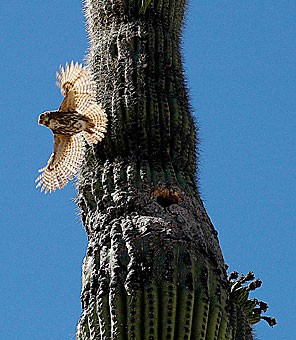For the past seven years a UA researcher has camped out in northern Mexico during the hot summer months looking for owl pellets and excrement.
Aaron Flesch, a senior research specialist in the School of Natural Resources, has become skilled at finding the cactus ferruginous pygmy owl, a 3-ounce, 6-inch “”reddish-tinged”” owl that lives in lowland areas of Southern Arizona and Northern Mexico.
Listed as an endangered species in 1997, the pygmy owl was taken off the list by the U.S. Fish and Wildlife Service in 2005, even though the owl has nearly disappeared in the U.S., said Robert Steidl, an associate professor in the School of Natural Resources.
The U.S. Fish and Wildlife Service didn’t consider the pygmy owls in the U.S. to be distinct from the populations of pygmy owls in Mexico, Steidl said.
“”Everyone assumed for a while that the populations in Mexico were OK, but they’re not,”” said Steidl, who wrote the study analyzing the data collected by Flesch.
The study found the populations of the owl in Northern Mexico have declined by about 26 percent over the past seven years, and conservation groups are hoping that fact might put the pygmy owl back on the endangered species list.
Flesch began tracking pygmy owl populations as a graduate student at the UA in 1999.
“”At that point, there was very little information on them, “” Flesch said. At the time, there were about 20 pygmy owls in the Tucson area. Today, no known pygmy owls exist in Tucson.
Flesch’s research has been aimed at assessing the status of the owl in Sonora, Mexico, over time and finding its implications on the recovery of pygmy owls in Arizona.
Flesch has tracked owls up to 100 kilometers into northern Mexico and 220 kilometer across the U.S.-Mexico border between Organ Pipe Cactus National Monument and Magdelena, Mexico.
Flesch and other volunteers, including UA students, have tracked 54 kilometers of wash tracts. Every 400 to 600 meters, they play a recording of a pygmy owl call to see if any male owls respond to locate the owls.
“”They’re very conspicuous,”” he said. “”They make a hell of a racket.””
Flesch said the male owls, which are highly territorial, respond to the call 100 percent of the time. About 110 different territories in all have been located, Flesch said.
The next task is finding the owls’ nests, which are usually found high in Saguaro cacti hollows made by gila woodpeckers.
They look for owl pellets, “”white wash,”” or owl droppings and the remains of the bird’s prey, which sometimes turn up birds as large as the owls themselves.
“”They’re ferocious little animals,”” Flesch said.
“”They’re very
conspicuous. They make a hell of a racket.
“”
– Aaron Flesch,
senior research specialist,
School of Natural
Resources
Flesch uses a micro-camera system that allow them to view the nests on a video screen, even in darkness.
“”We stick this camera system up on an extendable pole, which sounds technical but it’s really just a painting pole, or two of them, stuck together,”” Flesch said. “”We check these cavities in the saguaros, and we can see the nest and count the number of eggs.””
The nests are also monitored once the eggs hatch, and the young owls are counted again within a week before they leave the nest.
Since 2000, Flesch has gone back annually to see if the territories are still occupied by the owls from mid-April, when the owls begin laying their nests after the full moon, until late June, when the fledglings are about a week from leaving the nest.
The land they survey is almost exclusively privately or community-owned, said Flesch, which required building relations with the Mexican landowners for permission to survey their lands.
Although they’re often working in border areas where smuggling occurs, the landowners and local law enforcement havehelped make sure they’re safe and they’ve never had any problems, Flesch said.
The study also found that weather had a major impact on the populations. The populations declined in years when winter rainfall was low.
Woodcutting, agriculture and other human activity that disturbs the owls’ nests also decreases the owl population.
Flesch is hoping for government and non-government funding sources to continue the study, which costs about $10,000 to $12,000 a year.
The study findings could lead to repopulation efforts in Arizona by relocating owls from Mexico if stable populations are found there, Flesch said.
Flesch said the study also has possible implications for other Sonoran Desert animals because the pygmy owl populates the same endangered habitat as many other species.
The Center for Biological Diversity and the Defenders of Wildlife, nonprofit conservation organizations, are hoping the study will help put the species back on the endangered species list, said Noah Greenwald, a conservation biologist with the Center for Biological Diversity.
Both organizations are suing the U.S. Fish and Wildlife Service for delisting the species, Greenwald said.









